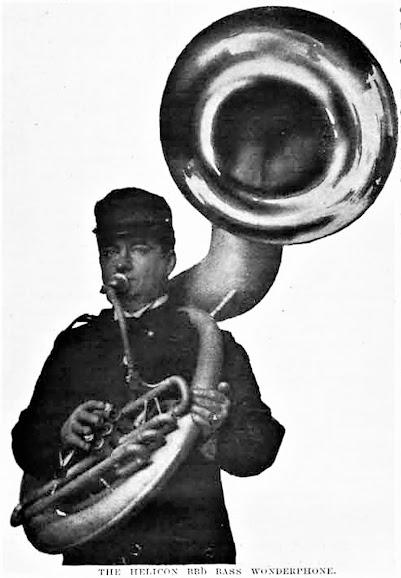On December 26, 1907, Charles G. Conn drafted a letter to the U. S. Patent Office that would bring a dramatic change to the Sousaphone, as well as to other bell-up instruments. Here's a portion of what he wrote:
The object of my invention is to construct the bells of brass wind musical instruments with curved axes and by attaching these curved bells to the bell-tubes of the instruments by means of curved sleeves, to provide a bell-front instrument having a much larger field of adjustment than heretofore.
The result was what Conn called the Wonderphone family of band instruments. The Sousaphone, with its upright bell, would begin to fade away as the new "Helicon BBb Bass Wonderphone" would eventually take over the Sousaphone market, as well as the name, in roughly five years (the earliest known reference to a Wonderphone helicon being called a "Sousaphone Grand" is from 1913).
The Music Trade Review of 1908 was all abuzz with excitement over Conn's new creation. Here's the first article that appeared, in the February 1 edition:
Regarding tubas, we've typically referred to those original forward-facing bells as "recording bells," due to how they must have helped in the early years of the recording industry. But nothing is said about that in the article above.Rather, the emphasis is on 1) how it would make a concert band sound better, with all of the bells pointing forward, and 2) how, in a marching band, the bells could be "directed backward toward the marching column if so desired." Whether anyone actually did that is another question!
Although it does sort of make sense, as I've noticed that in the rare instances when the Sousa Band marched, the Sousaphone and tubas were in the front rank, so perhaps being able to point their bells backwards might have helped the band follow the bass line better (although Sousa had no interest in Conn's creation; he stuck with the original bell-up design to the very end of his career!).
Here's an example of what I'm talking about, from 1900, when the band was marching in Paris:
In the February 22, 1908 edition of The Music Trade Review, so just three weeks after the initial article, we learn more - and we get a rare look at Conn playing one of his inventions!











No comments:
Post a Comment